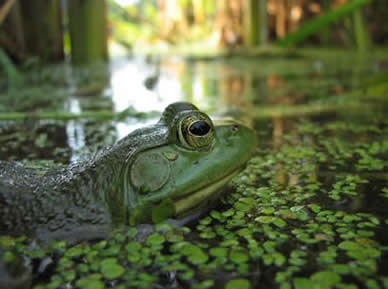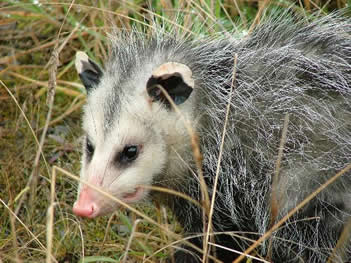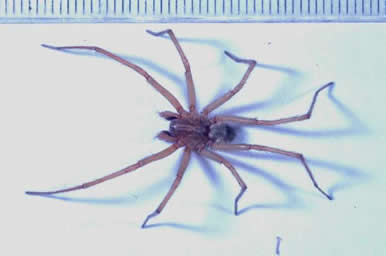

Alien and INVASIVE animal SPECIES in British columbia

American bullfrog (Rana catesbeiana), photo by Corey Cartwright.
Read historical information about alien and invasive plant species in BC.
Not all of the wildlife species you see in British Columbia are native to the province. Many are alien species, species that have arrived here from other parts of the globe. Some of these are now found in marine, aquatic and terrestrial habitats in the province. Some are accidental introductions, such as marine species that arrived here in ship's ballast or that were introduced along with oysters brought in for commercial harvest (Waldichuk et al. 1994). Others were introduced intentionally for fishing or hunting, or as a food (e.g. American Bullfrog). Some are species that were introduced in the adjacent US, and which have spread into BC (e.g. Wild Turkey, Virginia Opossum). Whatever their origin, these alien species are now part of the fauna of British Columbia, and have become established in our ecosystems and some have become invasive--disrupting ecosystems and displacing native species.
In this section of E-Fauna BC, we introduce you to some of the alien species in the province--both familiar and unfamiliar--including feral species, domestic species that have 'gone wild' and are now part of the fauna of BC.

Oyster processing at an oyster farm in Fanny Bay, Vancouver Island. Oyster farming is one source of alien species introductions.
Photo by Brian Klinkenberg.
Some Familiar Introduced Species
Some familiar introduced species in BC include the American Bullfrog. This species was introduced to BC as a food source and frogs were released into the wild when this was unsuccessful. Today, most ponds, ditches and lakes in the Greater Vancouver area support populations of this species. Populations are established in the Fraser Valley, and eastern Vancouver Island--and bullfrogs have been reported from the Okanagan (BC Ministry of Environment 2009).
Another familiar species, and one that has been introduced to BC repeatedly, is the Atlantic Salmon. Repeated introductions were made because initial attempts seemed unsuccessful, and introduction is augmented today by escapees from fish farms along the BC coast where millions of Atlantic Salmon are reared. Successful spawning of this species has been recorded in our rivers; however, it is not known if self-sustaining populations are present. McPhail (2010) feels the species could potentially be established: "the possibility that Atlantic salmon could become established on the B.C. coast can no longer be dismissed out of hand". Fishers are also familiar with the introduced Largemouth Bass and Smallmouth Bass, both of which were introduced to the province to provide angling opportunities (McPhail 2010).

Virginia Opossum (Didelphis virginiana), photo by Jamie Fenneman
If you have walked along the beaches at Boundary Bay, you will have noticed the amazing abundance of Asian hornsnail. In some spots, they form a thick carpet of shells. And in many places along our coast you will have noticed the Pacific or Japanese oyster--those large white irregular-looking shells are distinctive. This species is imported for commercial harvest and was introduced to BC in the early 1900's. When the first oysters were imported from Japan, they also inadvertently included seed of the Manila clam (a.k.a. Japanese little-neck clam), a species now also established in BC. Harbo (2001) indicates that the Manilla clam was first recorded in BC in 1936.
The Virginia Opossum is frequently observed along the US/Canada border--along Zero Avenue at dusk as it crosses the road. Road kills are common. This species likely arrived in BC from Washington State, where it was introduced in the 1920's (Nagorsen 1996). However, it has since been introduced to Hornby Island (Nagorsen 1996, Shackleton pers. com.).
Many urban residents are well familiar with the Norway Rat and the Black Rat, two species that arrived early in our settlement history. The Norway Rat was common in Vancouver by the 1880's (Nagorsen 2005); both species likely arrived via ships.

Hobo spider, photo by Rob Higgins.
A Few Less Familiar Introduced Species
Some less familiar introduced species include the Nutria (Myocastor coypus), a large rodent from South America that was introduced to BC in the late 1930's. Populations of Nutria may or may not persist in BC, but sightings are occasionally reported.
One group of introduced species that we often don't think about are earthworms. Although we do have a small number of native earthworm species in BC, most earthworm species in BC, and across Canada, are introduced European species.
There is one introduced species in the province that alarms people--the Hobo Spider. This species is now established across southern BC. However, anecdotal reports of injury to humans are unsubstantiated. Read more about this species on our spider page.

Feral Goat, Saturna Island, photo by Olivia Lee.
Feral Species in BC
Several species have become feral in British Columbia over the years, including horses, goats, sheep, cattle and pigs (boar) (Shackleton 1999). Some have not established, while other continu to be present.
Wild horses can be seen in BC in the central interior where herds wander through the sagebrush and open rangelands. The actual numbers of wild horses in BC are relatively small, but they form bands that include a stallion and several mares and their offspring. Feral goats inhabit several Gulf Islands, including Saturna, Texada, Jedediah and Lesquetti islands. These are descended from livestock brought to the area. Feral goats on Saturna Island have had a dramatic impact on plant species composition. Shackleton (1999) indicates that at one time, camels were feral in BC (the two-humped or Bactrian camel), brought in during the gold rush era as pack animals.
Historical Material on E-Fauna BC
In E-Fauna BC, we provide two historical publications on introduced or alien species in the province:
1) Text from the old publication Alien Animals in British Columbia--written by G. Cliford Carl and C. J. Guiguet in 1958--is provided because of the historical importance of the information it contains. Read the text.
2) A copy of the 1994 article
Exotic Introductions into BC Marine Waters:
Major Trends--written by
Michael Waldichuk, Philip Lambert, and Brian Smiley-- is also provided. Read the article.
References
Harbo, Rick M. Shells and Shellfish of the Pacific Northwest: A Field Guide. Harbour Publishing, Madeira Park, BC.
Carl, G. Cliford and C. J. Guiguet. 1958. Alien Animals in British Columbia. British Columbia Provincial Museum, Department of Education, Handbook No. 14. Victoria, BC.
McPhail, Don. Atlantic Salmon atlas page: BC distribution and notes. In: Klinkenberg, Brian (Editor) 2010. E-Fauna BC: Electronic Atlas of the Fauna of British Columbia [www.efauna.bc.ca]. Lab for Advanced Spatial Analysis, Department of Geography, University of British Columbia, Vancouver.
Nagorsen, David W. 2005. Rodents and Lagomorphs of British Columbia. Royal BC Museum Handbook. Royal BC Museum, Victoria.
Shackleton, David. 1999. Hoofed Mammals of British Columbia. Royal BC Museum Handbook. Royal British Columbia Museum, Victoria.
Waldichuk, M., P. Lambert and B. Smiley. 1994. Exotic Introductions into BC Marine Waters. Pp. 220-223. In Biodiversity in British Columbia, edited by L. Harding and E. McCullum. Ottawa: Environment Canada.
Please cite these pages as:
Author, date, page title. In: Klinkenberg, Brian. (Editor) 2023. E-Fauna BC: Electronic Atlas of the Fauna of British Columbia [www.efauna.bc.ca]. Department of Geography, University of British Columbia, Vancouver. [Date Accessed]
© Copyright 2023 E-Fauna BC.